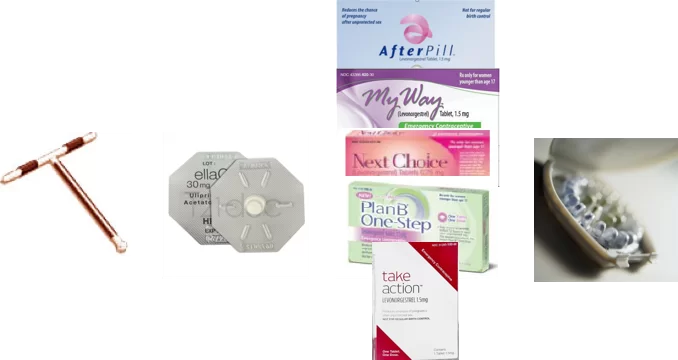Medically reviewed by Sophia Yen, MD, MPH – Written by Pandia Health Editorial Team
Emergency contraception (EC) is usually an afterthought, but at Pandia Health, we want you to treat EC like a fire extinguisher. You want it ready in your house when an emergency happens – no running to the pharmacy, worrying if it has EC in stock, whether it’s covered by your insurance, or if the pharmacist will give it to you.
Like birth control, many of those with uteri don’t realize there is more than one option for EC and that some are better than others. In this post, we break down the wild world of EC to give women peace of mind in what can be a stressful situation.

The Four Types of Emergency Contraception
There’s more out there than Plan B! I bet that you and many doctors don’t know that:
- The copper IUD is the most effective form of EC. (New research shows you can use the hormonal IUD for EC)
- Ella (ulipristal acetate) is the second most effective form of EC.
- Plan B and its generic equivalents are the third most effective form.
- The Yuzpe method of taking a specific combination of birth control pills (100 mcg of ethinyl estradiol and 1 mg of norgestrel now and again in 12 hours) is the least effective, but it’s better than nothing if all you have is a pack of pills

Forget Cuddling – Move, Move, Move!
EC can be used for up to 5 days after contraceptive failure or penetrative heterosexual assault but that doesn’t mean you should take your time. Although the copper IUD is equally effective throughout the five days, it’s best to take the pill form of EC ASAP.
Dr Sophia Yen, our CEO and Co-Founder says, “If the condom breaks at 3am, the medicine should be in the woman’s mouth by 3:10. No cuddling or waiting for the “morning after.” Get on it!
Literally Not A One Size Fits All
If your BMI is 30 or greater, if you use Plan B or its generic equivalents, then your have a 8x greater odds of getting pregnant compared to someone with a BMI of 25 or less2. You read that right! It’s literally not a one size (or weight) fits all.
If your Body Mass Index (BMI) is 26 or greater, Plan B and its generics are as effective as a tic tac for preventing pregnancy. If your BMI is 30 or greater, when you use Plan B or its generic equivalents, your odds of getting pregnant compared to someone with a BMI less than 25 are eight times greater! It’s literally not a one size (or weight) fits all.
“If it were me or my daughter that needed EC, I would choose the copper IUD or Ella because of their greater efficacy at all time points and for those with BMI of 26 or greater.”
– Dr. Yen
Here is Dr. Yen’s take on EC and BMI based on these 3 studies3
| Your BMI | Plan B (or generics) | Ella | Copper IUD/Hormonal IUD |
| < 26 | Up to 5 days, best ASAP | Up to 5 days, best ASAP | Same throughout 5 days, MOST effective |
| 26-34 | No efficacy, can try doubling up | Up to 5 days, best ASAP | Same throughout 5 days, MOST effective |
| 35 or greater | No efficacy, can try doubling up, consider copper IUD | Lower efficacy, consider copper IUD | Same throughout 5 days, MOST effective |
TLDR: the IUD is best followed by ella, and then Plan B or its generics.
If your BMI is 26 or greater, consider an IUD or Ella.
If your BMI is 35 or greater, best to go with an IUD.
If you can’t get an IUD or ella, then consider doubling up on your dose of Plan B or its generic if your BMI is 26 or greater.
“Another pharmacokinetic study (involving 32 women) similarly found that 24 hours after ingesting LNG serum concentration levels were 50% lower among obese-BMI women. Following use of UPA, however, blood levels were similar among obese-BMI and normal-BMI women.”4
(LNG = Plan B and its generics and UPA = Ella or ulipristal acetate)
Know the Law
Under the Affordable Care Act there should be no copay and no deductible for any FDA approved method of birth control – this includes the copper IUD, Ella, and Plan B and its generics (though it’s harder to get for Plan B and generics because they are over the counter). If you have any problems getting it covered for NO copay, no deductible, contact the National Women’s Law Center for help.
You can use EC as many times as needed. However using a regular birth control method will prevent more pregnancies.
“They (EC pills) aren’t intended to be used as a regular form of contraception. But you can use emergency contraception more than once in a menstrual cycle if you need to.”
National Health System of the United Kingdom:
Do not use EC as your regular “Plan A, go to” contraception because EC does NOT work as well as regular birth control (ring, patch, pill, IUDs, implant, shots). EC can fail 25% of the time, depending where you are in your cycle and how soon you take the medication vs. the other methods which only fail 2% or 1/1000 depending on the method.

Here’s our video on EC
Expert Care by Expert Doctors with Pandia Health #PandiaPeaceOfMind
Want to #SkipTheTrip to the pharmacy to get EC? All customers of Pandia Health’s telemedicine service are offered a prescription for EC, either Ella or a Plan B generic, at no extra charge. If you want to be covered in case of an emergency, sign up for Pandia Health’s birth control delivery service. Learn more about birth control with FREE delivery on our website, and contact us with any questions.
Check out our video on EC, this trusted source by doctors about EC, and an in-depth research document on the latest in EC (updated monthly by Princeton).
Disclaimer: The above information is for general informational purposes only and is NOT a substitute for professional medical advice. Always seek the advice of your doctor/primary care provider before starting or changing treatment.
1 When I gave lectures to Stanford internal medicine residents in 2018, only 1 out of 60 resident physicians knew about the copper IUD and Ella and that they work better than Plan B and its generic equivalents. When I give lectures to doctors, most don’t know about Ella and the latest research about EC.
2 Festin MP, Peregoudov A, Seuc A, Kiarie J, Temmerman M. Effect of BMI and body weight on pregnancy rates with LNG as emergency contraception: analysis of four WHO HRP studies. Contraception. 2017;95:50-4.
3 Glasier A, Cameron ST, Blithe D, Scherrer B, Mathe H, Levy D, Gainer E, Ulmann A. Can we identify women at risk of pregnancy despite using emergency contraception? Data from randomized trials of ulipristal acetate and levonorgestrel. Contraception. 2011;84:363-7.
Moreau C, Trussell J. Results from pooled Phase III studies of ulipristal acetate for emergency contraception. Contraception. 2012;86:673-680.
Edelman A, Cherala G, Blue S, Erikson D, Jensen J. Impact of obesity on the pharmacokinetics of levonorgestrel-based emergency contraception: single and double dosing. Contraception. 2016 ;94:52-57.
4 Praditpan P, Hamouie A, Basaraba CN, Nadakumar R, Cremers S, Davis AR, Westhoff CL. Pharmacokinetics of levonorgestrel and ulipristal acetate emergency contraception in women with normal and obese body mass index. Contraception. 2017;95:464-9.

